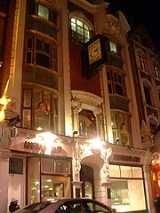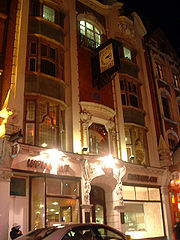
Wong Kei
Encyclopedia

Chinatown, London
The name Chinatown has been used at different times to describe different places in London. The present Chinatown is part of the Soho area of the City of Westminster, occupying the area in and around Gerrard Street...
. It is one of the largest Chinese restaurants in the UK with seating for around 500 diners.
Building
Wong Kei is situated at 41–43 Wardour StreetWardour Street
Wardour Street is a street in Soho, London. It is a one-way street south to north from Leicester Square, up through Chinatown, across Shaftesbury Avenue to Oxford Street.-History:...
, which used to belong to Willy Clarkson (1861–1934), a famous theatrical wig maker and costumier, as attested by the 1966 blue plaque
Blue plaque
A blue plaque is a permanent sign installed in a public place to commemorate a link between that location and a famous person or event, serving as a historical marker....
on the facade.
"It was designed by the architect H. M. Wakeley. Inscriptions record that the wig-making business was established in 1833, that Sarah Bernhardt
Sarah Bernhardt
Sarah Bernhardt was a French stage and early film actress, and has been referred to as "the most famous actress the world has ever known". Bernhardt made her fame on the stages of France in the 1870s, and was soon in demand in Europe and the Americas...
laid the foundation stone of the present building in 1904 and Sir Henry Irving
Henry Irving
Sir Henry Irving , born John Henry Brodribb, was an English stage actor in the Victorian era, known as an actor-manager because he took complete responsibility for season after season at the Lyceum Theatre, establishing himself and his company as...
the coping stone in 1905. Street directories show that Clarkson's occupied the premises from 1905 until 1940."
"The building contains four storeys and a garret. The front, with a width of three broad windows, is designed in a style combining Baroque
Baroque
The Baroque is a period and the style that used exaggerated motion and clear, easily interpreted detail to produce drama, tension, exuberance, and grandeur in sculpture, painting, literature, dance, and music...
and art nouveau
Art Nouveau
Art Nouveau is an international philosophy and style of art, architecture and applied art—especially the decorative arts—that were most popular during 1890–1910. The name "Art Nouveau" is French for "new art"...
forms, realised in brick and green stone with buff stone dressings. The doorway is centred between display windows, and at either end of the ground floor an Ionic
Ionic order
The Ionic order forms one of the three orders or organizational systems of classical architecture, the other two canonic orders being the Doric and the Corinthian...
pilaster with garlanded capital supports a great bracket-stop upon which stands a large urn with a tall conical top."

Cartouche (design)
A cartouche is an oval or oblong design with a slightly convex surface, typically edged with ornamental scrollwork. It is used to hold a painted or low relief design....
."
"On either side of the flat-headed central first-floor window is a cartouche
Cartouche (design)
A cartouche is an oval or oblong design with a slightly convex surface, typically edged with ornamental scrollwork. It is used to hold a painted or low relief design....
, one inscribed 'Estb. 1833', the other 'Rebt. 1904'. From the centre of the second floor is suspended on wrought-iron brackets a double faced clock inscribed 'Costumier Perruquier' on both sides. On either side of the door metal plaques record the visits of Bernhardt and Irving mentioned above."
In 1972, another Chinese restaurant, called Lee Ho Fook occupied the ground floor of the building.
External links
- Museum of London collections, details and a 1972 drawing of the building
- History of the Building and Clarkson's Wigs

